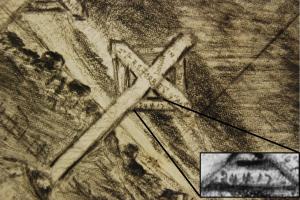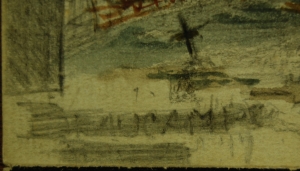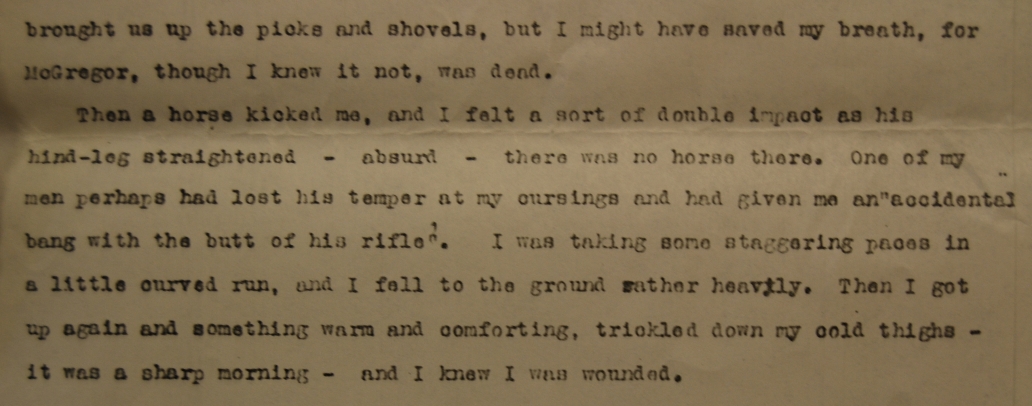I’m currently enhancing the description of First World War-related items in Professor John Duncan Mackie’s personal papers (ref. DC 32). These are mostly bundles of letters and photographs, covering especially Captain Mackie’s time recovering from wounds sustained at the front line.
One of these files contained the drawings above, on page 5 of a letter. Because only this single page of the letter has survived, I reasoned that it had been kept because of the drawings instead of the content of the letter. Which made me wonder: why had Mackie chosen to keep this single page? What was particularly significant about the two soldiers depicted?
Fortunately, the pencil drawing includes the names of the soldiers’ graves depicted: Lieutenant W.J. Lawson, and 2nd Lieutenant R.S. Forbes, both members of ‘C’ Company of the 14th Argyll & Sutherland Highlanders.

Close-up of R.S. Forbes’ grave,showing 24 April 1917 as the date of his death.
The Commonwealth War Graves Commission’s website provides information on all British soldiers who died during the First World War. Robert Forbes and William Lawson were indeed buried together, having died on 24 April 1917, aged 23 and 21 respectively.
Curiously, the location ‘Beaucamps’ appears on the full colour drawing, but has been crossed out. The Commonwealth War Graves Commission’s concentration records shed light on why: Robert Forbes and William Lawson’s graves were only moved to Gouzeaucourt New British Cemetery in 1919. Their original resting place is given as 57c Q.18.b.6.6 – a grid reference for trench maps. The National

‘Beaucamps’ crossed out
Library of Scotland has digitised their collection of trench maps; this sheet covers the specified grid reference, showing that Forbes and Lawson were originally buried on Beaucamp Ridge, overlooking the ruined villages of Beaucamp and Villiers-Plouche. So it seems likely that the location has been updated following these graves being moved.
The final answer to why Mackie had chosen to keep these drawings only became apparent after reading Mackie’s account of ‘Being Wounded’. Mackie sustained two serious injuries during the War; the collection includes many letters from Mackie regarding the injury to his arm due to shrapnel in October 1918, but there is very little on his previous injury. ‘Being Wounded’ describes an attack on a village in April 1917 which appeared to be going well until Mackie and his men were surprised by machine gun fire on their right flank. Mackie was hit in the stomach, and several of his men killed.

Extract from ‘Being Wounded’, DC32/12/53. Photocopy – originals held at the Imperial War Museum, ref. Documents.15333
Mackie’s Forces War Record confirms that he was wounded on 24 April 1917, the same day that Forbes and Lawson died. It is even possible that Robert Forbes or William Lawson were killed by the same machine gun which wounded Mackie himself. Mackie’s fortunate survival may have made Robert Forbes and William Lawson’s deaths especially poignant in his eyes, as men who were not so lucky. This is ultimately speculative, but it is the most convincing explanation for why Mackie kept a memento relating only to their deaths.
I cannot say whether Mackie was close to Forbes or Lawson. However, Mackie saved a memorial picture of William Lawson inside an earlier issue of the battalion’s magazine (which Mackie himself edited); this further suggests that Lawson’s death had a particular impact on him.
At the same time that Mackie his men were fighting at Beaucamp, only 30 miles to the north-east many other soldiers from Glasgow took part in the Arras Offensive. Next Tuesday there will be a free talk at Kelvin Hall on Glasgow’s part in one of the largest battles of 1917.
Categories: Archives and Special Collections


 Are you dancing?: The Scottish Ballet Archive
Are you dancing?: The Scottish Ballet Archive  Johnny Beattie: ‘The Clown Prince of Scotland’
Johnny Beattie: ‘The Clown Prince of Scotland’  Lou and Kitty: a friendship in letters
Lou and Kitty: a friendship in letters  Preserving History: Challenges of Storing Old Beer Bottles and Cans in Archives and Special Collections Storage
Preserving History: Challenges of Storing Old Beer Bottles and Cans in Archives and Special Collections Storage
Leave a comment